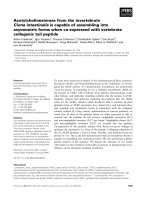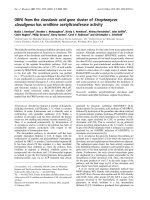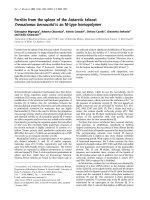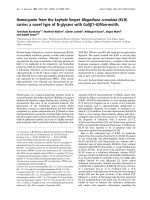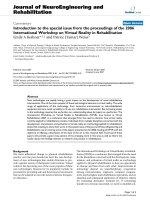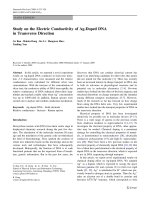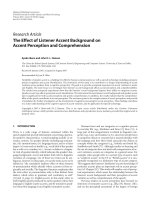Báo cáo hóa học: " Message from the Editor-in-Chief" ppt
Bạn đang xem bản rút gọn của tài liệu. Xem và tải ngay bản đầy đủ của tài liệu tại đây (419.67 KB, 2 trang )
EURASIP Journal on Applied Signal Processing 2004:1, 1–2
c
2004 Hindawi Publishing Corporation
Message from the Editor-in-Chief
Marc Moonen
Department of Electrical Engineering, Katholieke Universiteit Leuven, ESAT-SISTA,
Kasteelpark Arenberg 10, B-3001 Hever lee, Belgium
Email:
After having served for one year as Editor-in-Chief of
EURASIP JASP, I believe it is appropriate to look back and
evaluate the status of our journal, list strengths and weak-
nesses, and prepare plans for the future. My predecessor Prof.
K. J. Ray Liu (University of Maryland, College Park, USA) left
the jour nal in perfect health after having initiated its spectac-
ular rise, as w itnessed, for example, by the number of sub-
mitted and published papers. I have a vivid recollection of
my dress rehearsal during the 2002 Christmas break as well
as my first few months as Editor-in-Chief, early 2003, which
were par ticularly hectic and chaotic. Especially at that time, I
realized it was going to be difficult to match the high standard
that Ray set.
Some of the initial energy was invested into tra nsferring
the web-based manuscript tracking system (MTS) from the
University of Maryland to Hindawi Publishing Corporation,
as well as into further tuning the system and expanding its
functionality. The system has now a few thousands of regis-
tered users, a nd I believe it has proven to be both reliable and
easy to use. However, we are still open to suggestions and are
willing to invest more effort into further improving and ex-
panding our system.
EURASIP JASP owes much of its success to its out-
standing Editorial Board. The Editorial Board is responsi-
ble for organizing regular paper reviews and—even more
importantly—for the definition and selection of suitable top-
ics for the special issues. In 2003, we started bringing in ten
new Editorial Board Members each half year, based on nomi-
nations from the Editorial Board. On July 1st, our new Edito-
rial Board Members were: Prof. Jacob Benesty (Universite du
Quebec, Montreal, Canada); Prof. Helmut Boelcskei (Swiss
Federal Institute of Technology (ETH), Zurich, Switzerland);
Prof. Chong-Yung Chi (National Tsing Hua University, Tai-
wan); Prof. Fulvio Gini (University of Pisa, Pisa, Italy); Dr.
Alexei Gorokhov (Philips Research, Eindhoven, The Nether-
lands); Prof. Peter Handel (Royal Institute of Technology
(KTH), Stockholm, Sweden); Prof. John Homer (The Uni-
versity of Queensland, Brisbane, Australia); Prof. Mark Kahrs
(University of Pittsburgh, Pittsburgh, USA); Prof. Bernie
Mulgrew (University of Edinburgh, Edinburgh, UK); Prof.
Douglas Williams (Georgia Institute of Technology, Atlanta,
USA).
I would now also like to take the opportunity to wel-
come our new Editorial Board Members (term starting Jan-
uary 1st): Dr. Satya Dharanipragada (IBM T.J. Watson Re-
search Center, USA); Prof. Douglas O’Shaughnessy (Uni-
versity of Quebec, Montreal, Canada); Prof Sharon Gan-
not (Bar-Ilan University, Ramat-Gan, Israel); Prof. Moon Gi
Kang (Yonsei University, Seoul, Korea); Prof. Thomas Kaiser
(Gerhard Mercator University, Duisburg, Germany); Prof.
Mark Liao (Academia Sinica, Taiwan); Prof. Montse Par-
das ( Polytechnic University of Catalonia, Barcelona, Spain);
Prof. Markus Rupp (Vienna University of Technology, Vi-
enna, Austria); Dr. Bill Sandham (ScotSig, Glasgow, UK);
Prof. Jacques Verly (University of Liege, Liege, Belgium).
At the same time I would also like to express my heartfelt
thanks to the Editorial Board Members who have finished
their term in 2003: Prof. Shih-Fu Chang (Columbia Uni-
versity, New York, USA); Prof. Jie Chen (Brown University,
Providence, USA); Prof. Tsuhan Chen (Carnegie Mellon Uni-
versity, Pittsburgh, USA); Prof. Pierre Duhamel (Sup
´
elec,
Gif-sur-Yvette, France); Prof. Yu Hen Hu (University of Wis-
consin, Madison, USA); Prof. S. Y. Kung (Princeton Uni-
versity, Princeton, USA); Prof. Heinrich Meyr (Aachen Uni-
versity of Technology, Aachen, Germany); Prof. Jose M. F.
Moura (Carnegie Mellon University, Pittsburgh, USA); Prof.
Takao Nishitani (NEC, Japan); Prof. Bjorn Ottersten (Royal
Institute of Technology (KTH), Stockholm, Sweden); Prof.
Zhi Ding (University of California, Davis, USA); Prof. Tariq
Durrani (University of Strathclyde, Glasgow, UK); Prof. Ton
Kalker (Philips Research & TU Eindhoven, Eindhoven, The
Netherlands); Prof. Bastiaan Kleijn (Royal Institute of Tech-
nology, Stockholm, Sweden); Dr. Ut-Va Koc (Bell Labs, Lu-
cent Technologies, USA); Prof. Ferran Marqu
´
es (University
of Catalonia, Barcelona, S pain); Dr. Naohisa Ohta (SONY,
Japan); Dr. Mukund Padmanabhan (Renaissance Technolo-
gies Corporation, USA); Dr. Tomohiko Taniguchi (Fujitsu
Labs, Japan); Prof. Kung Yao (University of California, Los
2 EURASIP Journal on Applied Signal Processing
Angeles, USA). Their editorial work has been highly appreci-
ated and crucial to the success of the journal.
In 2003, EURASIP JASP became one of the first journals
to support the “Open Access” model, a new business model
for academic publishing that enables research articles to be
freely accessible online. EURASIP JASP currently employs a
hybrid model in which part of the journal is restricted to sub-
scribers and part is free to everyone. Authors are now g iven
the option of paying an “Open Access Fee” to make their ar-
ticle freely available on our website. As more authors will opt
for making their articles freely available, the subscription ra te
of the journal will be reduced to reflect this fac t. For more
information about the “Open Access” model, please contact
EURASIP JASP also started a “Publish-on-Demand”
model in 2003. Instead of always having 12 issues per year,
we now publish an “undetermined” number of issues each
year, based on the flow of accepted manuscripts. For 2004,
we have quoted 16± issues, which means that we expect pub-
lishing about 16 issues (regular issues and special issues), but
we could (and most probably will) have more, as more spe-
cial issues will be finalized in time and the inflow of regular
papers has increased significantly. In 2003, we launched 14
new special issues, w hich will be published in 2004 and 2005.
Based on the number of papers submitted to EURASIP JASP
in 2003, the number of published papers/pages will certainly
increase in 2004. The number of submissions was already 275
in 2001 and 361 in 2002. In 2003, the number of submissions
grew beyond our wildest expectations to 679 (180 regular pa-
pers, 499 special-issue papers). Receiving these statistics from
the Publisher certainly renewed much my own initial enthu-
siasm about the journal. These statistics confirm we are on
track to become one of the leading journals in the field!
For 2004, our target will be to minimally collect as many
paper submissions as in 2003 and to launch some 14 new spe-
cial issues. Furthermore, we will work hard to make our pa-
per review process even more efficient, where our target will
be to have a first round editorial decision consistently within
three to four months from the submission date. To achieve
this, I would again like to encourage everyone to support our
journal by submitting papers, by assisting in reviewing pa-
pers, by suggesting special issue topics, and by writing to us,
expressing ideas and suggestions. The journal will certainly
benefit greatly from your comments and feedback.
Finally, I sincerely wish to thank again my Editorial
Board, and especially Senior Advisory Editor K. J. Ray Liu,
for their magnificent effortsandsupport,aswellasDr.
Ahmed Hindawi and his technical staff at Hindawi Publish-
ing Corporation for the wonderful cooperation we have.
Marc Moonen
Editor-in-Chief
